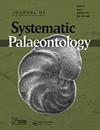青藏高原紫荆属植物(Fabaceae)最古老的化石记录揭示了其进化和生物地理意义
IF 2.2
2区 地球科学
Q3 EVOLUTIONARY BIOLOGY
引用次数: 0
摘要
摘要紫荆属(bauhinia s.s.)是豆科植物中的一个大属,但由于化石记录的缺乏,其进化和生物地理历史与泛热带地区高度多样化的现代物种相比仍不清楚。本文报道了紫荆花属植物最早的化石记录,即紫荆花西藏(Bauhinia tibetensis Y. Gao et T. Su sp. nov.),基于藏南地区古新世晚期的叶片。结合古生态位模拟和祖先状态重建,这些新化石表明紫荆属起源于古新世的非洲热带地区,随后分散到新热带和印多马拉亚地区。西藏紫荆花属紫荆花属亚洲分支,在古新世早期从非洲热带地区经科希斯坦-拉达克岛弧到达西藏南部地区。这个分支在渐新世传播到中国东南部,在新近纪或更早时期进入印度北部。在青藏高原南部发现的最古老的紫荆属植物更新了我们对该属生物地理历史的认识,并证明了科希斯坦-拉达克岛弧是非洲和印度植物区系交流的古老走廊。感谢中国科学院西双版纳热带植物园古生态课题组成员和中国科学院昆明植物研究所的同事们所做的化石收集工作。感谢中国科学院西双版纳热带植物园技术设施共享中心提供成像设备和协助化石扫描。国家重点研发计划项目(2022YFF0800800)、青藏高原第二次科学考察计划项目(2019QZKK0705)、国家自然科学基金(41988101)、中国科学院战略重点研究计划项目(XDB26000000)、中国科学院青年创新促进会项目(Y2021105)、云南省基础研究项目(YNWR-QNBJ-2019-086)资助。披露声明作者未报告潜在的利益冲突。补充材料本文的补充材料可以在这里访问:http://dx.doi.org/10.1080/14772019.2023.2244495.Associate编辑:Paul Kenrick本文章由计算机程序翻译,如有差异,请以英文原文为准。
The oldest fossil record of Bauhinia s.s. (Fabaceae) from the Tibetan Plateau sheds light on its evolutionary and biogeographic implications
AbstractBauhinia s.s. is a large genus in the family Fabaceae, but its evolutionary and biogeographical history is still unclear due to the scarcity of fossil records compared to the highly diverse modern species in pantropic regions. Here, we report the earliest fossil record of Bauhinia s.s., namely Bauhinia tibetensis Y. Gao et T. Su sp. nov., based on leaves from the latest Paleocene of the southern Tibetan region. Combined with palaeoecological niche simulations and ancestral state reconstruction, the new fossils suggested a Paleocene origin of Bauhinia s.s. in the Afrotropical realm that subsequently dispersed to the Neotropical and Indomalayan realms. Bauhinia tibetensis belongs to the Asian clade of Bauhinia s.s. that reached the southern Tibetan region from the Afrotropical realm via the Kohistan-Ladakh Island Arc in the early Paleocene. This clade spread to south-eastern China during the Oligocene and entered northern India during the Neogene or earlier. The discovery of the oldest Bauhinia s.s. from what is now the southern Tibetan Plateau updates our understanding of the biogeographical history of this genus and demonstrates that the Kohistan-Ladakh Island Arc is an ancient corridor for floristic interchange between Africa and India.Keywords: Bauhinia s.s.biogeographydiversificationPaleoceneleaf fossilpalaeoecological niche simulations AcknowledgementsWe thank the members of the Paleoecology Research Group from Xishuangbanna Tropical Botanical Garden, Chinese Academy of Sciences (CAS) and colleagues from Kunming Institute of Botany, CAS for fossil collection works. We thank the Institutional Center for Shared Technologies and Facilities of Xishuangbanna Tropical Botanical Garden, CAS for providing imaging equipment and assisting with fossil scans. This work is supported by the National Key Research and Development Program (2022YFF0800800), the Second Tibetan Plateau Scientific Expedition program (2019QZKK0705), the National Natural Science Foundation of China (NSFC) (41988101), the Strategic Priority Research Program of the Chinese Academy of Sciences (CAS) (XDB26000000), the Youth Innovation Promotion Association, CAS (Y2021105), and the Basic Research Project in Yunnan (YNWR-QNBJ-2019-086).Disclosure statementNo potential conflict of interest was reported by the author(s).Supplemental materialSupplemental material for this article can be accessed here: http://dx.doi.org/10.1080/14772019.2023.2244495.Associate Editor: Paul Kenrick
求助全文
通过发布文献求助,成功后即可免费获取论文全文。
去求助
来源期刊
CiteScore
5.30
自引率
7.70%
发文量
31
审稿时长
>12 weeks
期刊介绍:
The Journal of Systematic Palaeontology publishes papers that provide novel and impactful results in phylogenetics and systematics and that use these results in ways that significantly advance rigorous analyses of palaeogeography, palaeobiology, functional morphology, palaeoecology or biostratigraphy. Papers dealing with theoretical issues or molecular phylogenetics are also considered if they are of relevance to palaeo-systematists. Contributions that include substantial anatomical descriptions, descriptions of new taxa or taxonomic revisions are welcome, but must also include a substantial systematics component, such as a new phylogeny or a revised higher-level classification. Papers dealing primarily with alpha-taxonomic descriptions, the presentation of new faunal/floristic records or minor revisions to species- or genus-level classifications do not fall within the remit of the journal.

 求助内容:
求助内容: 应助结果提醒方式:
应助结果提醒方式:


